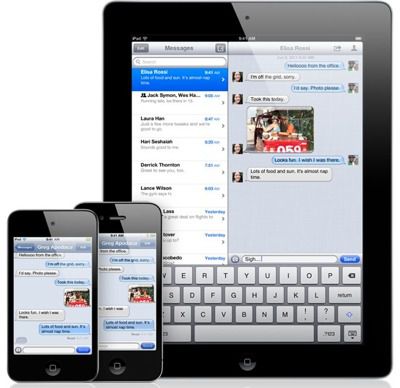Apple's iMessage Delivery Problems Worsened by Server Glitch
iPhone owners switching from their iPhone to another device often encounter an issue with lost messages that are incorrectly delivered to their inactive iPhone, instead of their new phone. This issue is a long-standing problem that was recently made worse by a server glitch, claims Apple in a statement provided to Re/code.

Apple's iMessage service allows iPhone owners to exchange messages using Apple's iMessage servers, instead of the carrier's text messaging network. The system relies on the accurate identification of the originating and recipient devices as iPhones. When this identification fails, the message delivery system falls apart.
The lost messages problem arises when an iPhone owner switches to another smartphone, such as an Android device, and keeps their existing number. In select cases, Apple's iMessage service continues to recognize the phone number as being attached to an iPhone, instead of the new Android device. This recognition mistake causes a problem with messaging as Apple's iMessaging servers will route the message as an iMessage instead of converting it to a standard text message.
Apple advises iPhone owners to turn off iMessage on their phone and uncheck the number in other iMessage-compatible devices attached their iCloud account before switching devices. This method doesn't always remove the phone number from Apple's iMessage server, forcing former iPhone owners to contact Apple to remove them from the iMessage system manually. A recent server glitch has disabled this manual removal, leaving Apple support representatives temporarily unable to fix this problem for some customers.
“We recently fixed a server-side iMessage bug which was causing an issue for some users, and we have an additional bug fix in a future software update,” Apple told Re/code in a statement. “For users still experiencing an issue, please contact AppleCare.”
Apple has not provided a time-frame for the release of this software update. Until a fix is in place, customers will have to contact AppleCare for further guidance on how to handle this troublesome issue.
Popular Stories
While the iPhone 17 Pro and iPhone 17 Pro Max are not expected to launch until September, there are already plenty of rumors about the devices.
Below, we recap key changes rumored for the iPhone 17 Pro models as of April 2025:
Aluminum frame: iPhone 17 Pro models are rumored to have an aluminum frame, whereas the iPhone 15 Pro and iPhone 16 Pro models have a titanium frame, and the iPhone ...
Apple is preparing a "bold" new iPhone Pro model for the iPhone's 20th anniversary in 2027, according to Bloomberg's Mark Gurman. As part of what's being described as a "major shake-up," Apple is said to be developing a design that makes more extensive use of glass – and this could point directly to the display itself.
Here's the case for Apple releasing a truly all-screen iPhone with no...
The first iOS 19 beta is less than two months away, and there are already a handful of new features that are expected with the update.
Apple should release the first iOS 19 beta to developers immediately following the WWDC 2025 keynote, which is scheduled for Monday, June 9. Following beta testing, the update should be released to the general public in September.
Below, we recap the key...
If you have been experiencing issues with wireless CarPlay in your vehicle lately, it was likely due to a software bug that has now been fixed.
Apple released iOS 18.4.1 today, and the update's release notes say it "addresses a rare issue that prevents wireless CarPlay connection in certain vehicles."
If wireless CarPlay was acting up for you, updating your iPhone to iOS 18.4.1 should...
Apple may have updated several iPads and Macs late last year and early this year, but there are still multiple new devices that we're looking forward to seeing in 2025. Most will come in September or October, but there could be a few surprises before then.
We've rounded up a list of everything that we're still waiting to see from Apple in 2025.
iPhone 17, 17 Air, and 17 Pro - We get...
Apple's upcoming foldable iPhone (or "iPhone Fold") will feature two screens as part of its book-style design, and a Chinese leaker claims to know the resolutions for both of them.
According to the Weibo-based account Digital Chat Station, the inner display, which is approximately 7.76 inches, will use a 2,713 x 1,920 resolution and feature "under-screen camera technology." Meanwhile, the...
Apple today released iOS 18.4.1 and iPadOS 18.4.1, minor updates to the iOS 18 and iPadOS 18 operating systems that came out last September. iOS 18.4.1 and iPadOS 18.4.1 come two weeks after the launch of iOS 18.4 and iPadOS 18.4.
The new software can be downloaded on eligible iPhones and iPads over-the-air by going to Settings > General > Software Update.
There have been complaints about ...
Apple has confirmed that it will be permanently closing its retail store in the heart of Bristol, England, and there is no replacement in sight.
Apple Bristol in 2023
Apple Bristol will be closing its doors on Saturday, August 9, due to redevelopment plans at the Cabot Circus Shopping Centre, and the adjacent Bristol Shopping Quarter. According to news reports, and a building application, the ...
Apple today updated its vintage products list to add the 2018 Mac mini and the iPhone 6s, devices that will get more limited service and repairs now that they are considered vintage.
The iPhone 6s initially launched in 2015, but Apple kept it around as a low-cost device until 2018, which is why it is only now being added to the vintage list. The iPhone 6s had Apple's A9 chip, and it was...
























